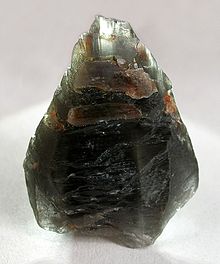Sillimanite
| Sillimanite | |
|---|---|
 | |
| General | |
| Category | Nesosilicate |
| Formula (repeating unit) | Al2SiO5 |
| IMA symbol | Sil[1] |
| Strunz classification | 9.AF.05 |
| Dana classification | 52.02.02a.01 |
| Crystal system | Orthorhombic |
| Crystal class | Dipyramidal (mmm) H-M symbol: (2/m 2/m 2/m) |
| Space group | Pbnm |
| Unit cell | a = 7.47 Å, b = 7.66 Å c = 5.75 Å; Z = 4 |
| Identification | |
| Color | Colourless or white to grey, also brown, yellow, yellow-green, grey-green, blue-green, blue; colourless in thin section |
| Crystal habit | Prismatic crystals, fibrous, acicular |
| Cleavage | {010} perfect |
| Fracture | Splintery |
| Tenacity | Tough |
| Mohs scale hardness | 7 |
| Luster | Vitreous to subadamantine, silky |
| Streak | White |
| Diaphaneity | Transparent to translucent |
| Specific gravity | 3.24 |
| Optical properties | Biaxial (+) |
| Refractive index | nα = 1.653 – 1.661 nβ = 1.654 – 1.670 nγ = 1.669 – 1.684 |
| Birefringence | δ = 0.020 – 0.022 |
| Pleochroism | Colourless to pale brown to yellow |
| 2V angle | 21–30° |
| References | [2][3][4][5] |
Sillimanite or fibrolite is an aluminosilicate mineral with the chemical formula Al2SiO5. Sillimanite is named after the American chemist Benjamin Silliman (1779–1864). It was first described in 1824 for an occurrence in Chester, Connecticut.[4]
Occurrence[edit]
Sillimanite or fibrolite is one of three aluminosilicate polymorphs, the other two being andalusite and kyanite. A common variety of sillimanite is known as fibrolite, so named because the mineral appears like a bunch of fibres twisted together when viewed in thin section or even by the naked eye. Both the fibrous and traditional forms of sillimanite are common in metamorphosed sedimentary rocks. It is an index mineral indicating high temperature but variable pressure. Example rocks include gneiss and granulite. It occurs with andalusite, kyanite, potassium feldspar, almandine, cordierite, biotite and quartz in schist, gneiss, hornfels and also rarely in pegmatites.[3] Dumortierite and mullite are similar mineral species found in porcelain.[7]
Sillimanite has been found in Brandywine Springs, New Castle County, Delaware. It was named by the State Legislature in 1977 as the state mineral of Delaware by the suggestion of the Delaware Mineralogical Society.[8]
Uses[edit]
Natural sillimanite is used in the manufacture of high alumina refractories or 55–60% alumina bricks. However, it has mostly been replaced by the other aluminosilicate polymorphs, andalusite and kyanite, for this purpose.[9] As of 1998[update], sillimanite was just 2% of all aluminosilicate mineral production in the western world.[10]
Gallery[edit]
-
Silimanite crystal from Sri Lanka
-
Fibrolite micrograph
See also[edit]
References[edit]
- ^ Warr, L.N. (2021). "IMA–CNMNC approved mineral symbols". Mineralogical Magazine. 85 (3): 291–320. Bibcode:2021MinM...85..291W. doi:10.1180/mgm.2021.43. S2CID 235729616.
- ^ "WebMineral entry". Retrieved 2009-12-19.
- ^ a b http://rruff.geo.arizona.edu/doclib/hom/sillimanite.pdf Handbook of Mineralogy
- ^ a b http://www.mindat.org/min-3662.html Mindat.org
- ^ MacKenzie, W. S.; Guilford, C. (1980). Atlas of rock-forming minerals in thin section. Essex: Longman Scientific & Technical. p. 10. ISBN 0-582-45591-X.
- ^ Whitney, D.L. (2002). "Coexisting andalusite, kyanite, and sillimanite: Sequential formation of three Al2SiO5 polymorphs during progressive metamorphism near the triple point, Sivrihisar, Turkey". American Mineralogist. 87 (4): 405–416. doi:10.2138/am-2002-0404.
- ^ Klein, Cornelis and Cornelius S. Hurlbut, Jr., Manual of Mineralogy, 1985, Wiley 20th ed., p. 380 ISBN 0-471-80580-7
- ^ "Delaware State Mineral – Delaware Geological Survey". Archived from the original on 2010-06-10. Retrieved 2009-12-19. Delaware State Mineral, Sillimanite, Delaware Geological Survey
- ^ Gilchrist, J.D. (1977). "Alumino-Silicate Refractories". Fuels, Furnaces and Refractories: 258–272. doi:10.1016/B978-0-08-020430-7.50027-X. ISBN 9780080204307.
- ^ Ihlen, Peter M. (2000). "Utilisation of sillimanite minerals, their geology, and potential occurrences in Norway – an overview" (PDF). Geological Survey of Norway Bulletin. 436: 113. Retrieved 14 March 2022.



